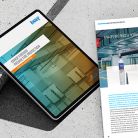The purpose of the passive fire protection is to limit the damaging effects of the fire within a building. This is achieved by installing suitable fire resistant construction elements. FireWin products provide dependable protection and in, with the help of this article, we will introduce you to our three products – three sealing solutions.
A Knauf FireWin specialist demonstrates a variety of sealing solutions that can be used for the same pipes in the same construction. Learn more about Knauf FPG Graphite, Knauf Firecollar, Knauf Firewrap, and Knauf FPC Panel installation. In all the cases FireWin specialist uses pipe – Ø110 mm and construction – W112 Knauf metal stud partition – CW50 stud frame, double-layer Knauf Diamant GKFI 12,5 mm cladding. Total wall thickness – 100 mm.
Knauf Fire Protection Graphite – FPG
Fire stopping of small gaps (10 - 30mm wide)
Knauf Fire Protection Graphite is a high specification formulation designed to prevent the spread of fire, smoke and gases through openings in the fire rated walls and floors. Unlike traditional intumescent sealants, Knauf FPG Graphite expands extensively when subjected to heat and closes around combustible pipes.

Installation:
-
Before installing Knauf Fire Protection Graphite ensure that all the service penetrations and surrounding construction surfaces are completely free from loose contaminants, dust, and grease.
- As Knauf Fire Protection Graphite is water based, in cases where corrosion protection is a problem, some metals may require a barrier between the sealant and the metal surface prior to this installation.
- When installing any backing material, cut this slightly oversize and insert into the gap ensuring a tight friction fit. Ensure the correct depth is achieved.
- Fill the gap with Knauf Fire Protection Graphite to the required depth. Gap width must be between 10 to 30 mm.
- Apply the sealant generously avoiding air bubbles. Finish the bead with a moist spatula or pallet knife. Avoid excessive tooling/smoothing as this may make the seal surface wet and soft.
- Knauf Fire Protection Graphite may be overpaint with most emulsion or alkyd (gloss) paints.
Knauf Firecollar
Fire stopping of tiny gaps (0 – 10mm wide)
Knauf Firecollar is designed to maintain the fire resistance of fire rated walls and floors where these are breached by plastic pipes, and may be used for gypsum, masonry and concrete walls and floors.

Installation:
-
For sealing plastic pipes, a Knauf Firecollar is installed on both sides of the wall.
-
Before fitting the Firecollar ensure that any gaps between the pipe and the separating element are sealed as follows:
In gypsum walls gaps between the pipe and the construction below 8 mm must have a bead of Knauf FPA Acrylic to cover the opening, and for gaps 8 mm or above, the seal must be plugged with 25mm deep Knauf FPA Acrylic. - Place the Firecollar around the service penetration (pipe) and ensure that the fixing lugs are positioned tightly to the surface of the wall so that the anchors/fixings can be fully inserted.
- For uneven surfaces apply a sealing bead of Knauf FPA Acrylic between the wall and the Firecollar.
- Attach the Firecollar with steel screws, anchors or fixings that are suitable for the substrate that the Firecollar will be fitted to. For flexible walls use ≥ Ø4 mm gypsum wood screws or anchors with a length suitable for the number of boards that form the wall.
Note that on site where the penetration size is greater than the pipe diameter and/or the pipe is in an angle, an oversized collar can be used. Knauf Firecollars are tested ‘oversize’, i.e., the internal diameter of the Firecollar can be larger than the pipe.
Knauf Firewrap and Knauf FPC Panel
Fire stopping of large gaps (greater than 30mm wide)
Knauf Firewrap is designed to maintain the fire resistance of the fire separating walls and floors when these are breached by plastic pipes or metal pipes with continuous combustible insulation, and may be used for gypsum, masonry or concrete walls and concrete floors.
Knauf FPC Panel has been designed to maintain the fire resistance of the separating walls and floors where they are breached by a single or multiple building services. The panel consists of a stone wool core, sealed with Knauf FPC Coating on one or both faces.

Installation:
-
Ensure the faces of the aperture opening are free of dust and any other contaminants. The faces may be moistened for a better adhesion.
- Fix a suitable pipe wrap around the service penetration and fasten with the tape as tightly as possible in order to prevent any excess opening between the pipe wrap and the service.
- It is normal for walls to fit a wrap on both sides of the wall, again with the edge just visible.
-
Once the wrap is securely installed, fire seal the empty aperture surrounding the
pipe wraps as follows:
Walls with Knauf FPC Panel: Cut the required panels to suit the aperture dimensions and type and size of service penetrations. All the exposed and cut edges of the panels can be sealed with Knauf FPC Coating or Knauf FPA Acrylic prior to fitting which will act as an adhesive and ensure a smoke tight seal. All the joints, gaps or imperfections in the installed seal must be sealed on both sides with Knauf FPA Acrylic.
Once the installation is complete penetration seal system must be permanently marked with an identification plate.
Note that in many cases larger openings in construction should be reinforced with CW/ UW profiles.
Considering the easy-to-use benefits and effectiveness of the products, it is worth considering Knauf Fire Protection Graphite – FPG, Knauf Firecollar, Knauf Firewrap and Knauf FPC Panel for the fire protection of your building!
For more information and technical solutions please contact Knauf Fire Safety Specialists. Trust in Knauf FireWin system’s quality and build with a fire protection in mind!




